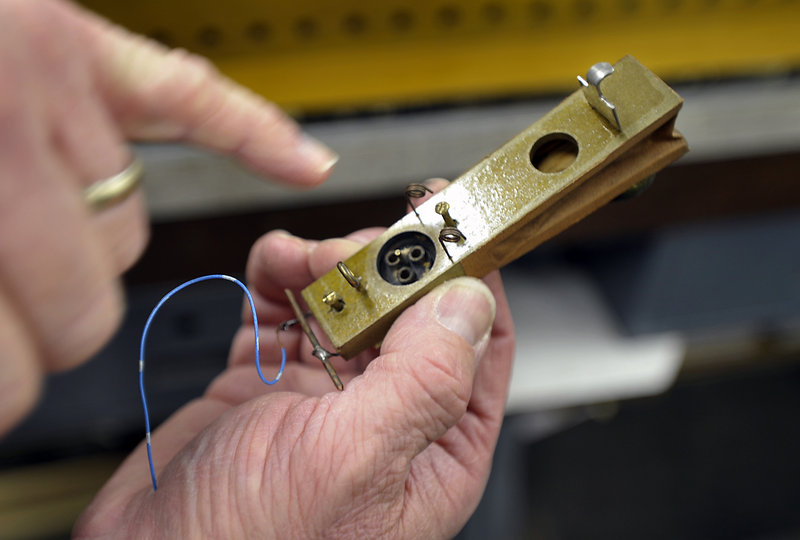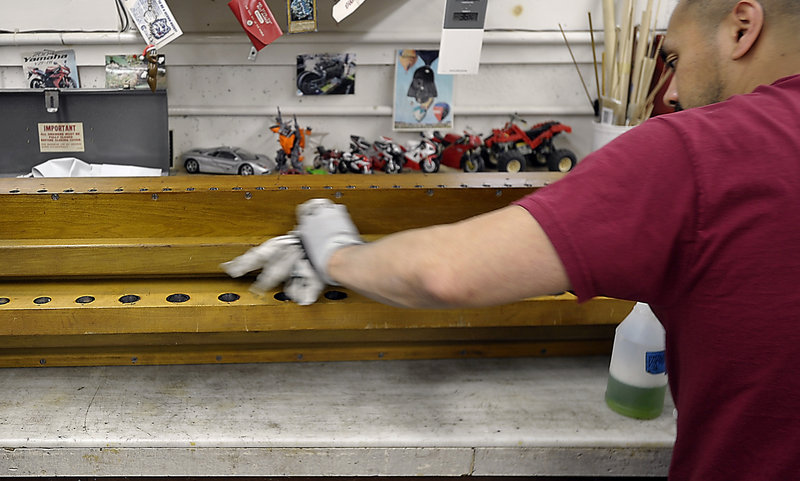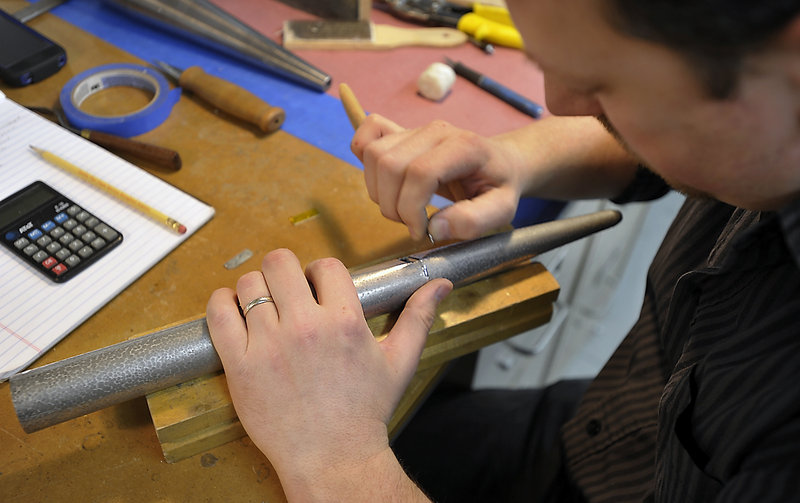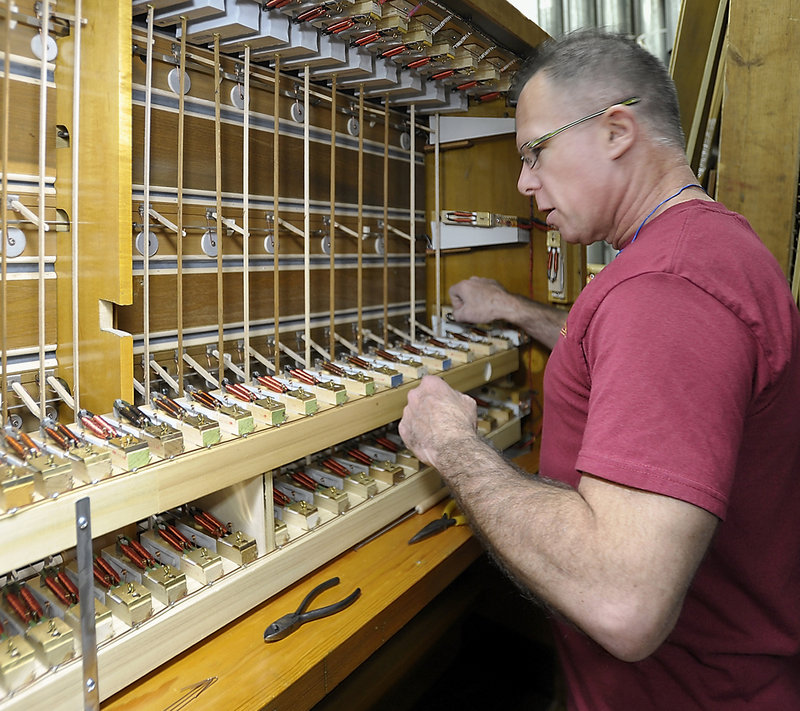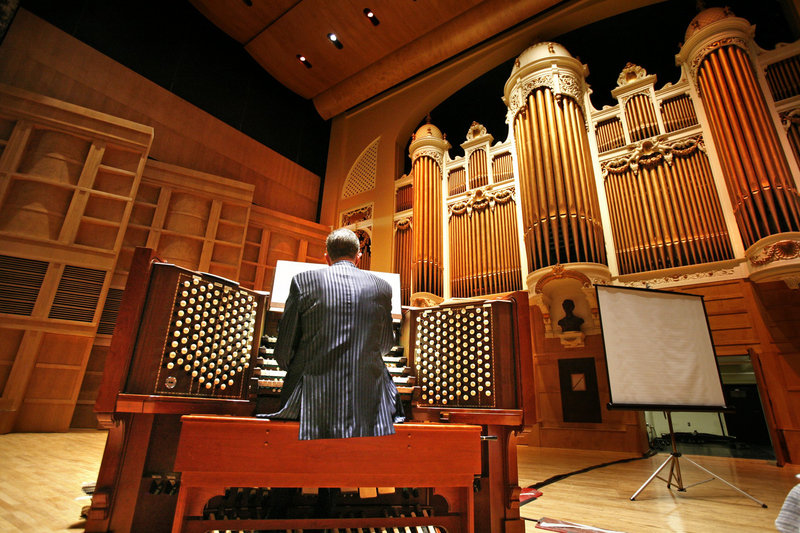TOLLAND, Conn. – Milovan Popovic holds a tiny metal pipe from Portland’s Kotzschmar Organ in the palm of his hand.
It is no larger than a pencil. He blows into an opening, and the pipe emits a whistle of air.
“This,” Popovic said, “is what the organ is all about. It’s such a beautiful sound.”
Known in the organ business as a voicer, Popovic makes an organ sing. He and other technicians with Foley-Baker Inc., the Connecticut-based company hired to refurbish Portland’s century-old organ, have spent most of the past year cleaning, fixing and refreshing the grand instrument. And it’s only half-finished.
It’s a task that’s not only being watched in Maine, but around the world. The Kotzschmar, whose home is Merrill Auditorium in Portland City Hall, is one of only two of its kind left in the United States — a turn-of-the-20th-century pipe organ that still serves as a municipal instrument and has a paid municipal organist.
It’s one of the more famous organs in North America, and one of the signature components of Portland arts and cultural life.
Michael Barone, who hosts the American Public Media radio program “Pipedreams,” said the Kotzschmar is known worldwide in organ circles.
“Because it has been used consistently through the past century and because it has generated notoriety not just in Portland but around the United States and indeed worldwide, it is one of the landmark pipe organs in the United States,” Barone said.
And once the massive refurbishment of all its parts is completed — the target date is summer 2014 — the Kotzschmar will sing as it was originally intended, a sound that hasn’t been heard properly in more than half a century.
A GIFT TO THE CITY
The organ was dedicated in August 1912, and was a gift to the city by from Cyrus Curtis, who grew up in Portland and made his fortune in the publishing business. Among other things, he published the Ladies’ Home Journal and the Saturday Evening Post, as well as several large newspapers.
Curtis named the organ for his friend, Hermann Kotzschmar, a native of Germany who came to Portland in the mid-1800s and stayed in the city until he died in 1908. He taught music here, and was among the first arts advocates in the city.
Kotzschmar lived with Curtis’ parents, who named their son in honor of their musical friend: He was christened Cyrus Hermann Kotzschmar Curtis.
The organ was the first municipal organ built in the U.S., and Portland remains one of two cities in America that owns an organ and employs a municipal organist. San Diego is the other. Almost all other municipal organs have been lost to time and neglect.
Portland almost lost the Kotzschmar as well. Many observers believe the organ would not be around today if not for the efforts of the Portland-based nonprofit group Friends of the Kotzschmar Organ, which has provided maintenance and upkeep on the instrument for three decades and spearheaded the current restoration.
The organ was disassembled and removed from Merrill Auditorium last summer after the instrument’s centennial celebration. The reinstallation process will begin in earnest this June, though it will not be completed for another year.
The Friends of the Kotzschmar Organ plans to celebrate the organ’s reinstallation in August 2014.
EXPERTISE COUNTS
Foley-Baker got the contract for the Kotzschmar restoration because of its expertise. There aren’t many companies in the country that could do the job, and Foley-Baker’s staff has a long history with pipe organs as well as an association with the company that built the Kotzschmar originally — the Austin Organ Co. of Hartford, Conn. Austin is still in operation, and has made some of the schematics from the original installation available to Foley-Baker.
Among other tasks, Popovic and his colleagues have dislodged 100-year-old dirt and grime from the nearly 7,000 metal and wooden pipes, and rebuilt, repaired, retooled and otherwise renewed the organ’s tractor-trailer-sized wind chest, a dozen or so air boxes, pneumatic controls, regulators, electronics, console and various other working parts.
The Foley-Baker shop on the outskirts of Hartford is packed with thousands of components from the organ, each and every part receiving individual attention and color-coded to ease its reinstallation.
“It’s big, it’s old and it’s been through a lot,” said Jim Bennett, shop foreman at Foley-Baker, who previously worked at Austin. “This is a very complex organ, and it’s a complicated job.”
The job is complicated because the Kotzschmar had a spotty history of maintenance. While the Friends of the Kotzschmar Organ has done a remarkable job keeping the organ in good working order since the group’s formation in 1981, the organ suffered neglect prior to that, Bennett said.
It was moved twice for renovations to City Hall, including a major renovation in the 1990s that resulted in the creation of Merrill Auditorium, and was pieced together and damaged in prior decades.
The price tag for this project is $2.6 million, half of which was raised privately. The city approved up to $1.25 million in bonds to pay its share. The Friends hopes to raise additional money to fund an endowment that will benefit the organ’s upkeep going forward, said Kathleen Grammer, executive director of the Friends of the Kotzschmar Organ.
A CHAMBER OF WIND
The current work is necessary because of a leaky wind chest, Grammer said.
Think of the wind chest as the organ’s lungs. It provides the air that pulses through the pipes, causing the organ to sing. The wind chest is a large chamber on which the rest of the organ sits, toward the back of Merrill and out of public view.
It is an air-lock chamber that is 53 feet long, 7 feet wide and 6 feet, 9 inches tall. The wind chest was originally 7 feet tall, but had been cut down to 5-foot-3 during a prior hall renovation. At 6-foot-9, the new wind chest will stand 3 inches short of its original height.
The process of rebuilding the wind chest began immediately after the organ was taken apart last summer, said Philip Carpenter, director of field service for Foley-Baker. It has been completely rebuilt with eastern white pine and poplar.
The craftsmen at Foley-Baker said they feel privileged to work on the organ. Foley-Baker cleared its schedule for two years to accommodate this project, Bennett said.
“It’s certainly a challenge, but it’s also a great opportunity,” he said. “This is a rare chance to be involved in the saving and restoration of one of the very few civic organs in the country. To be able to take the instrument out and reinstall it and give it a new life is a great opportunity.”
People will notice the difference in sound. “If they don’t, then there is something wrong with them,” Carpenter said.
The organ will be more responsive, with less hissing and more clarity of sound. Pipes that didn’t work or work well before will sound like they did in 1912.
“The organ will be healthy again,” Carpenter said. “Pipes need all the air they were designed to get in order to sound the way they are supposed to sound. They weren’t getting that air before. They will now.
“It’s an incredible instrument, and it’s going to be phenomenal.”
Staff Writer Bob Keyes can be contacted at 791-6457 or:
bkeyes@pressherald.com
Twitter: pphbkeyes
Send questions/comments to the editors.




